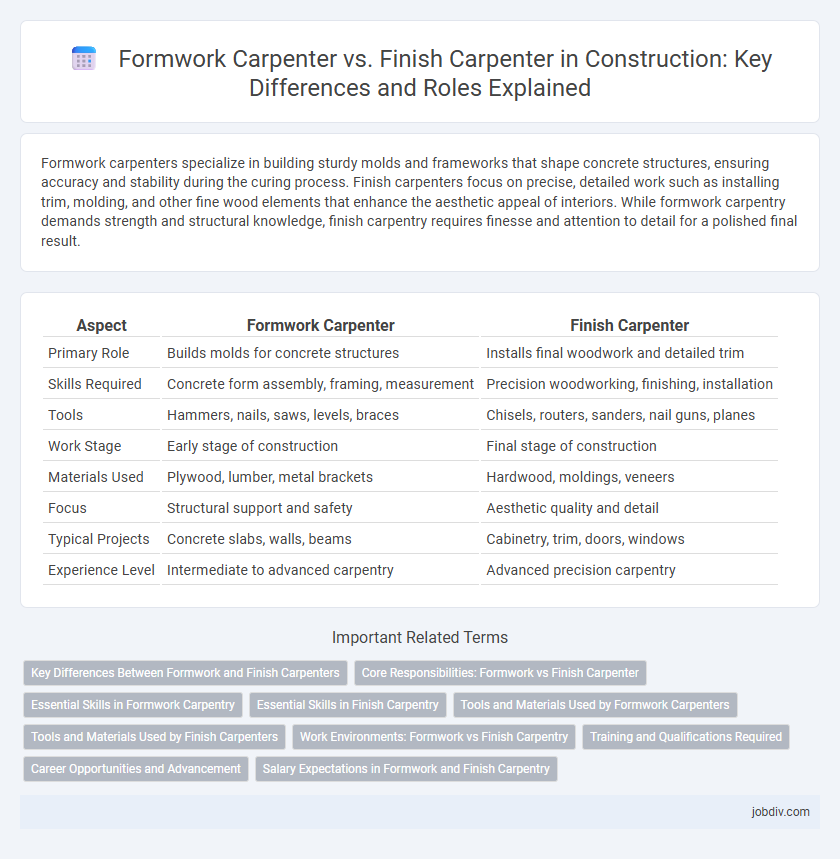Formwork carpenters specialize in building sturdy molds and frameworks that shape concrete structures, ensuring accuracy and stability during the curing process. Finish carpenters focus on precise, detailed work such as installing trim, molding, and other fine wood elements that enhance the aesthetic appeal of interiors. While formwork carpentry demands strength and structural knowledge, finish carpentry requires finesse and attention to detail for a polished final result.
Table of Comparison
| Aspect | Formwork Carpenter | Finish Carpenter |
|---|---|---|
| Primary Role | Builds molds for concrete structures | Installs final woodwork and detailed trim |
| Skills Required | Concrete form assembly, framing, measurement | Precision woodworking, finishing, installation |
| Tools | Hammers, nails, saws, levels, braces | Chisels, routers, sanders, nail guns, planes |
| Work Stage | Early stage of construction | Final stage of construction |
| Materials Used | Plywood, lumber, metal brackets | Hardwood, moldings, veneers |
| Focus | Structural support and safety | Aesthetic quality and detail |
| Typical Projects | Concrete slabs, walls, beams | Cabinetry, trim, doors, windows |
| Experience Level | Intermediate to advanced carpentry | Advanced precision carpentry |
Key Differences Between Formwork and Finish Carpenters
Formwork carpenters specialize in constructing temporary molds and structures to support concrete until it hardens, focusing on precise measurements and strong, durable frameworks. Finish carpenters concentrate on the final touches of construction, such as installing trim, molding, cabinetry, and other detailed woodwork that enhances the aesthetic appeal and functionality of a building. The primary difference lies in formwork carpenters working with large-scale structural components during early construction phases, while finish carpenters handle detailed, visible wood elements during the finishing stages.
Core Responsibilities: Formwork vs Finish Carpenter
Formwork carpenters specialize in constructing temporary molds and frameworks essential for shaping concrete structures, ensuring precision and structural integrity during the pouring process. Finish carpenters focus on detailed woodworking tasks such as installing trim, molding, cabinetry, and other aesthetic components that enhance the interior and exterior appearance of a building. The core responsibility of formwork carpenters centers on concrete support systems, while finish carpenters prioritize fine craftsmanship and surface detailing.
Essential Skills in Formwork Carpentry
Formwork carpenters specialize in constructing temporary molds and structures to support poured concrete, requiring precise measuring, cutting, and assembling skills to ensure stability and accurate dimensions. Mastery in reading blueprints and knowledge of various materials such as plywood, metal, and lumber are essential for creating safe and efficient formwork. These skills differ from finish carpentry, which centers on detailed trim work, requiring fine craftsmanship and aesthetic precision rather than structural expertise.
Essential Skills in Finish Carpentry
Finish carpenters require exceptional precision, expert knowledge of fine wood materials, and proficiency in installing detailed moldings, trim, and cabinetry to create aesthetically pleasing interiors. Their essential skills include advanced measuring, cutting, and joining techniques, along with a keen eye for alignment and surface finishing to ensure flawless results. Expertise in reading blueprints and adapting to varied architectural styles distinguishes finish carpentry from the more structural focus of formwork carpenters.
Tools and Materials Used by Formwork Carpenters
Formwork carpenters primarily use tools such as framing hammers, nail guns, saws, levels, and tape measures to create temporary molds that shape concrete structures. Their materials include plywood, lumber, metal form ties, and release agents that ensure the molds hold concrete securely and can be removed without damage. Precision in assembling durable formwork is critical to supporting wet concrete until it hardens, distinguishing their toolset and materials from those used by finish carpenters.
Tools and Materials Used by Finish Carpenters
Finish carpenters primarily use precision tools such as miter saws, nail guns, chisels, and planes to create detailed woodwork, trim, and cabinetry. Their materials often include hardwoods like oak, maple, or cherry, along with veneers, molding, and various decorative elements designed to enhance interior aesthetics. Unlike formwork carpenters who handle large-scale concrete molds and heavy-duty framing lumber, finish carpenters work with finer, more delicate components requiring exact measurements and smooth finishes.
Work Environments: Formwork vs Finish Carpentry
Formwork carpenters primarily work on construction sites, often in outdoor environments exposed to varying weather conditions, where they build temporary molds for concrete structures. Finish carpenters typically operate indoors in residential or commercial buildings, focusing on detailed woodworking that requires precision and clean surroundings. The work environment for formwork carpenters demands physical endurance and safety measures, while finish carpentry emphasizes fine craftsmanship and aesthetic quality.
Training and Qualifications Required
Formwork carpenters require specialized training in constructing temporary molds for concrete, emphasizing blueprint reading, safety standards, and materials handling. Finish carpenters focus on detailed woodworking skills, including precise cutting, installation of trim, molding, and cabinetry, often necessitating apprenticeship and mastery of hand tools. Both roles demand safety certifications and hands-on experience, but the technical skills and training pathways differ according to the nature of their carpentry work.
Career Opportunities and Advancement
Formwork carpenters specialize in constructing molds for concrete structures, offering career advancement through roles such as site supervisor, project manager, or estimator due to their essential skills in structural integrity. Finish carpenters focus on detailed woodwork, trim, and cabinetry, with opportunities to advance into roles like lead carpenter, design consultant, or custom woodworker, benefiting from expertise in aesthetics and precision. Both careers provide diverse pathways in construction, with formwork emphasizing structural frameworks and finish carpentry highlighting interior craftsmanship.
Salary Expectations in Formwork and Finish Carpentry
Formwork carpenters typically earn an average salary ranging from $40,000 to $60,000 annually, reflecting their specialized skills in shaping concrete structures and working on large-scale construction projects. Finish carpenters, focusing on detailed interior work like trim, molding, and cabinetry, generally command a slightly higher salary, often between $45,000 and $65,000 per year, due to the precision and craftsmanship required. Variations in salary depend on geographic location, experience level, and the complexity of projects involved in both formwork and finish carpentry trades.
Formwork Carpenter vs Finish Carpenter Infographic

 jobdiv.com
jobdiv.com